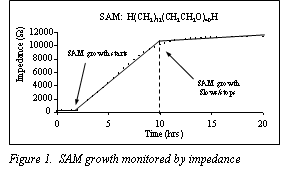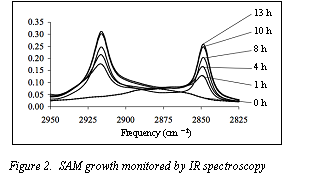

44430-G5
Characterization of the Ion Conductivity for Surface Modified Polymer Electrolyte Thin Films
In the past year we have continued to monitor the growth of a self-assembled monolayer on the surface of a polymer electrolyte. Results for this year have not significantly changed since last years report. In this work our goal was two fold. We wanted to show that SAM growth could be monitored over time using a unique electrochemical arrangement of ac. impedance spectroscopy coupled to an interdigitated microelectrode (IME). We also wanted to see how monolayer growth was altered using molecules with different molecular structures.
SAM formation was monitored for three different molecules. The molecules had the general formula H-(CH2)32 - (CH2CH2O)y–H, and differed only in the length of the ethylene oxide portion of the molecule ( y = 2, 10 and 40). Figure 1 shows a typical curve obtained for SAM growth on the polymer electrolyte surface. Impedance data showed that the growth times for the three molecules were measurably different from each other, but there was no direct correlation between growth times and molecule size.

To verify the ac. impedance technique as a viable means to monitor SAM growth, attenuated total reflection infrared spectroscopy (ATIR) was used. Figure 2 shows absorption data for the growth of a SAM layer over time. For comparison the molecule shown in figure 2 is the same as in figure 1. It was observed that growth times obtained via IR were similar to those obtained with impedance confirming the use of impedance coupled to the IME as a method for monitoring SAM growth.

A considerable amount of the reported results are attributed to the efforts of undergraduate student research through our summer research program and the use of this grant. Grant support has also been used to provide support for students to present this work at National ACS meetings. A no cost extension has been requested and approved in order to continue to use these funds to further support undergraduate research in the coming year.